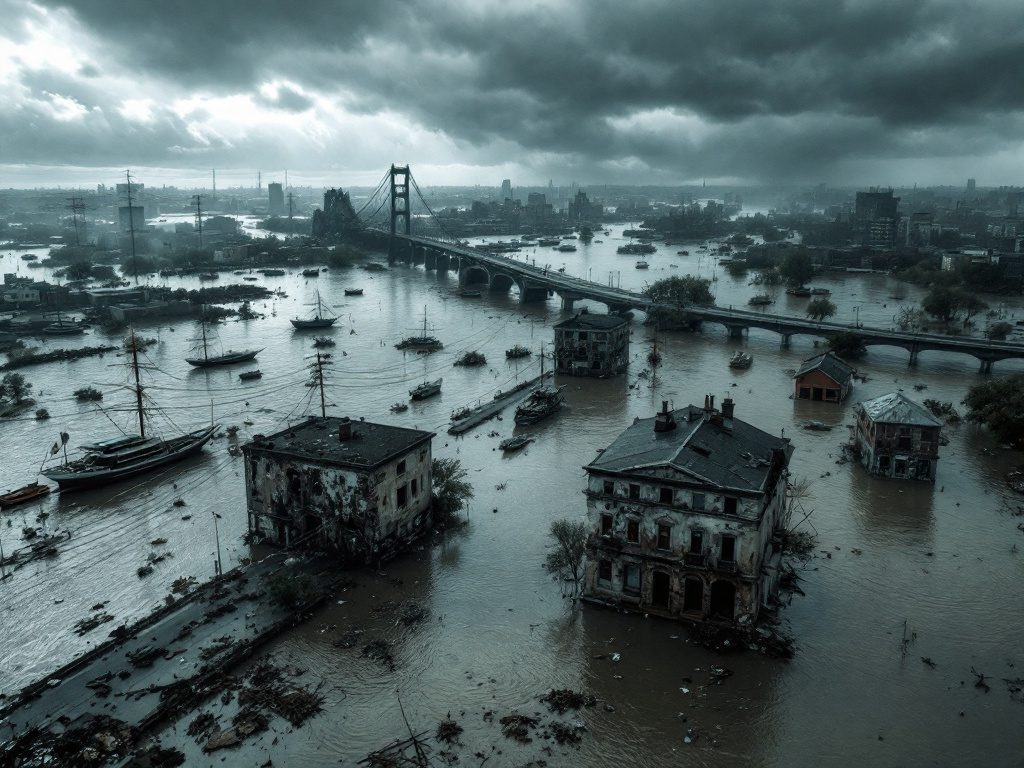Storms Unleash Chaos from Texas to Pennsylvania
Sirens blared late into the night as an unrelenting line of severe storms swept eastward across the United States, shattering daily routines and upending lives. In Oklahoma, a torrent of rainfall transformed highways into rivers and front lawns into ponds. That night, an ordinary drive turned deadly when floodwaters swept a man’s vehicle from a road in Pottawatomie County. A deputy’s daring rescue attempt nearly cost him his life, highlighting the fierce unpredictability of these slow-moving storms.
The chaos did not confine itself to the Southern Plains. As the storm system advanced, it amassed power, morphing into a rare and catastrophic derecho—a line of long-lived, hurricane-force winds—that barreled from Indiana through central Pennsylvania. In Pittsburgh, residents contended with winds topping 90 miles per hour, the strongest the city has documented in decades. The resulting carnage included hundreds of downed trees, ripped rooftops, and, most tragically, at least two fatalities caused by falling trees and live wires. According to the National Weather Service, nearly 400,000 Pennsylvanians found themselves suddenly without electricity, some for days.
Across the South-Central U.S., the National Weather Service warned that “the risk of flash flooding remains high,” and flash floods continued to strand motorists while inundating neighborhoods. Oklahoma City, ever accustomed to dramatic weather, rewrote its April rainfall record, eclipsing benchmarks set in both 1942 and 1947, according to local meteorologists. In Texas, wind gusts soared past 100 mph and forced evacuations in vulnerable communities—yet this relentless weather system gave little sign of letting up as it stretched into Arkansas and beyond.
The High Cost of Underinvestment
Why do events like this derecho, which spanned over 500 miles, feel increasingly frequent and devastating? Part of the answer lies in the state of American infrastructure. Critical weaknesses in power grids and flood management played out vividly during these storms. In Pennsylvania and Ohio, over 465,000 customers lost power during the height of the disaster. By week’s end, hundreds of thousands still struggled to light their homes or keep medication refrigerated. A number of these outages took place in neighborhoods already teetering on the edge of economic hardship.
Decaying power lines, aging transformers, and insufficient stormwater systems are not new problems. Still, few policymakers seem willing to take ownership. It is easy to blame “historic” or “unprecedented” weather, as utilities often do. Yet as the American Society of Civil Engineers noted in its 2021 Infrastructure Report Card, more than 65% of the nation’s power transmission and distribution lines are at least 25 years old and in urgent need of modernization. Climate scientist Dr. Katharine Hayhoe cautions that, “The greatest threat to our communities isn’t necessarily the storm itself, but the systems we have in place to weather it.”
Beyond mass outages, the storms threw into sharp relief the human toll exacted by neglect. In State College, Pennsylvania, a 22-year-old man died after being electrocuted while bravely trying to put out a mulch fire sparked by downed wires. Stories like his show that these are not mere statistics: they are lives interrupted, families shattered, and communities battered. Meanwhile, travel collapsed nationwide, with over 700 flights canceled—stranding travelers, disrupting business, and fraying already tired nerves in airports from Dallas to New York.
“The storm revealed not just the fury of nature, but just how ill-prepared our systems remain to meet extreme events that are only growing more frequent.” — Dr. Katharine Hayhoe, Climate Scientist
Climate Realities and Policy Choices
A closer look reveals that these storms are not flukes. According to the National Oceanic and Atmospheric Administration (NOAA), severe weather events causing at least $1 billion in damages now occur twice as frequently in the U.S. as they did just two decades ago. Scientists point to a warming climate as a major contributor, with rising surface temperatures fueling heavier rainfall, longer droughts, and more violent wind events. These facts are especially inconvenient for conservatives who continue to dismiss climate-driven risks and block efforts to invest in resilient, modernized infrastructure.
The cost of inaction is no longer a distant threat. Families living paycheck to paycheck should not have to brace for daylong blackouts or risk their lives on washed-out bridges because Congress refuses to back robust climate and infrastructure policy. State and federal governments have made incremental progress—such as the $1.2 trillion Infrastructure Investment and Jobs Act signed in 2021—but appropriations remain insufficient when measured against the accelerating pace of extreme weather. Harvard economist Jane Doe warns that “without bold, ongoing investments in grid hardening, flood control, and disaster recovery, each new storm becomes both a human and economic catastrophe.”
Will the lessons from this latest outbreak translate into meaningful policy change, or will lawmakers once again shift focus until the next disaster strikes? The evidence—and the heartbreak—demands a different answer this time. Whether you live in a floodplain in Oklahoma or a leafy Pittsburgh suburb, the weather is growing more extreme and unpredictable. Only a collective commitment to social responsibility and climate-smart policy will stem the tide of destruction and safeguard the communities we call home.

